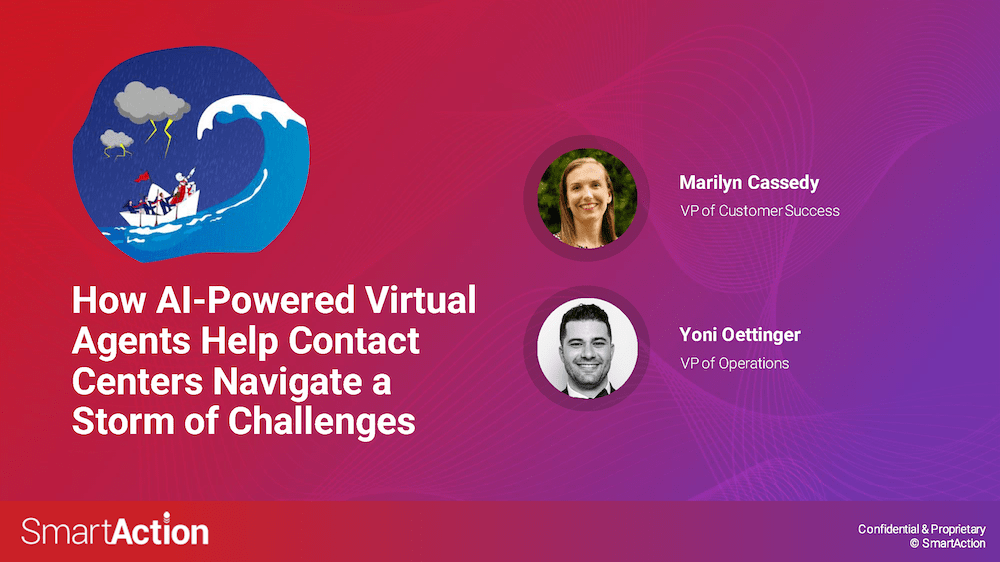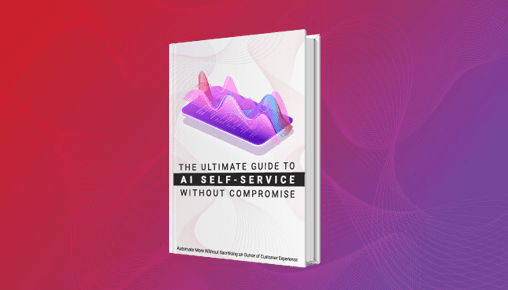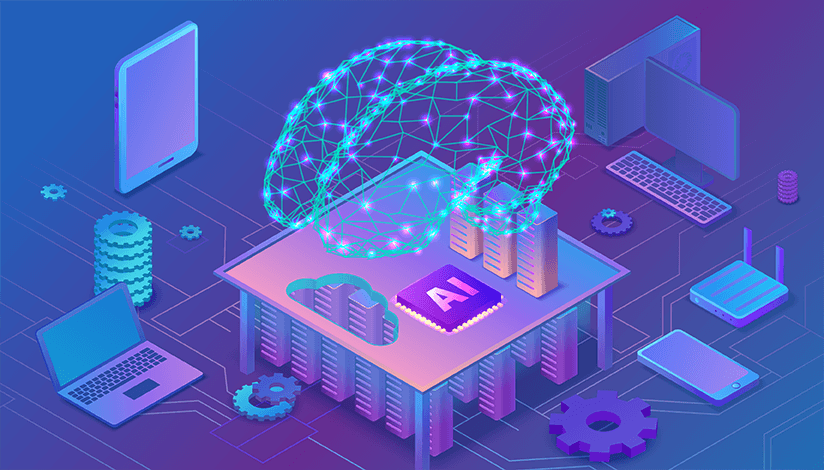How AI-Powered Virtual Agents Help Contact Centers Navigate a Storm of Challenges

Businesses are in a perfect storm of customer care challenges: Customer expectations are high (and rising!), call volumes are up, and live agents are leaving.
In this webinar, learn how an AI-Powered Virtual Agent can help companies navigate out of this storm, improve the front-line customer service and support experience and be better positioned than their competitors.
Learn how an Intelligent Virtual Agent (IVA) can:
- Deliver an excellent customer experience, on par with a live agent
- Handle complex interactions with the same or higher CSAT Score
- Reduce the high volume of repetitive calls that go to live agents to decrease burnout and turnover
Watch This
Webinar

Marilyn Cassedy
VP of Customer Success,
SmartAction

Yoni Oettinger
VP of Operations,
SmartAction
How AI-Powered Virtual Agents Help Contact Centers Navigate a Storm of Challenges
On-Demand Webinar
Laura Brooks (Host): Welcome everyone to today’s webinar. My name is Laura Brooks, your host and moderator. During the presentation I’d like to invite all participants to post any questions you may have in chat for our Q&A session. I’ll now start by introducing our speakers Marilyn Cassedy and Yoni Oettinger.
Yoni is the VP of operations at SmartAction and leads the project management Technical Account Management, Conversational Design and 24/7 support teams. He works closely with clients to ensure that their needs and requests are liaised properly with the SmartAction Engineering team. Yoni and his team are responsible for making sure all deliverables meet client standards. In his free time, you might find Yoni playing music around Austin with his band or out on a soccer pitch blocking shots.
Marilyn leads SmartAction’s Account Management group, and her mandate is to ensure that customers are getting the expected value from their applications. Over the past last five years, she has made it her priority to build collaborative relationships with SmartAction’s customers so that, together, they can not only achieve a great customer experience but also an impressive return on investment. When she’s not answering work emails, you’ll likely find her on a boat off the coast of Los Angeles where she lives.
Marilyn Cassedy (VP of Customer Success): Thanks, Laura. Thanks. Excited to be here.
Laura Brooks (Host): Now Marilyn will tell us a little bit about SmartAction itself and then we’ll discuss what our challenges are for the presentation.
Marilyn Cassedy (VP of Customer Success): Yeah, absolutely. I think that a little bit of context about SmartAction, who we are and what we do, can be really helpful for the coming conversation about call center challenges. And what SmartAction does is deliver AI-powered virtual agents as a service. It means we’re delivering the full conversational AI technology stack. It’s turnkey and it’s omnichannel.
That said, we’re really a voice-first solution. All of our current clients today are using our voice modules. But increasingly clients are relying on us not just for voice but also for digital channels, chat, text, et cetera. We incorporate best-of-breed AI and machine learning tools from Google, Microsoft, and others, alongside our proprietary tools, so that we can deliver the best possible experience in the marketplace.
I think the thing that sets us apart a little bit though is that we’re not just trying to sell a software license or a seat and you have to figure it out and do it yourself from there. Conversations with machines are complex and AI is a complex field that really requires experts. So we bundle our end-to-end customer experience, our conversational AI stack, alongside our services. Essentially, the work that Yoni and his team are doing that we just described.
So end-to-end is really everything — we’re managing the design, the build, and even the ongoing operation after Go Live because that tuning — the care and feeding of the application — is something that really does need to continue to go on for quite some time after that initial Go Live. We’re really stepping in as a partner, I think, in a lot of ways — and not just as a technology provider — and that has set us apart and allowed us to operate the customer experience for more than 100 brands in a number of industries and some of the highlights you see here.
Not just that, but we’ve been pretty successful at it. If you’re not already familiar with our Gartner Peer Insights page, we’re actually the most highly reviewed option in that marketplace. And so I encourage you after this webinar to go take a look at that and see what some of our customers are saying. If you go to the next slide then before we dive into some of these common contact center challenges, I think that “What Is Conversational AI?” is a really reasonable starting point.
It’s not just an IVR where you can press 1 for this, 2 for this or really one way and single path; think of conversational AI as a two-way exchange that’s much more dynamic. Just as with a human-to-human conversation, there’s hearing what the other person has said, and then there’s understanding. And that’s really, I think, in many ways the difference between an IVR and an IVR or intelligent virtual agent.
And in good speech recognition technology, you must have two AI engines, one for recognition — What did the caller actually say? — and then another for cognition when they said this word. What is the next step that we need to take? What does that mean? What do these words all together mean, and what is the intent of the caller? Something we’ll talk about a lot. There’s a lot of more advanced NLU and all that kind of stuff that we could get into in another webinar that’s more focused on the technology. But I think that having this basic understanding of the need for both recognition and cognition is a really good way to kind of set the groundwork for the work that we’re going to talk about here today.
Laura Brooks (Host): Thanks, Marilyn, for that introduction to today’s context center challenges and customer expectations — that they’re high and they’re rising. Of course, they’re also increasing our call volumes, and finding good people is difficult as agents are leaving and it’s clear they’re harder to replace.
So why don’t we get right into the first challenge? Marilyn and Yoni, how might a virtual agent solution tackle this problem?
Yoni Oettinger (VP of Operations): So we are seeing that clients are coming into our implementation. They have very high expectations of what we need to provide — both from our services and also from what the AI is doing. So they’re investing a lot in this technology and wanting to make sure that this succeeds and provides immediate ROI. And so it’s very important that we provide all of that to our clients. I know that a lot of times with our prospective clients, they know their call centers really well and there’s limited information that they know on the AI side. And a lot of what they’re hearing is coming out of, for example, SouthXSouthwest or CES in terms of where the future is going. And we have to contextualize what that means.
So it’s our responsibility to really make sure and inform them on how this technology fits into the call center, the relationship between the agents and the AI and always making sure that that the application is available to their callers and supplementing what the agents are doing. In a lot of cases this means not replacing an agent but making sure that we are freeing things up for them to do “more specific” tasks that they’ve been hired to do.
Marilyn Cassedy (VP of Customer Success): Do you think — just to jump in here — you make a really good point about how there’s this sort of broader atmosphere of AI is everywhere — it is changing the way that I interact with my home, interact with my car…
The customers that we’re working with have recognized that and are trying to figure out how to bring it to their call center. And it’s not as simple as plugging in an Echo or asking your phone’s assistant for a little bit of help finding a restaurant. These are a little bit more complicated, but customer demands really remain the same. And I think that’s one of the challenges that both of our teams face, right?
Yoni Oettinger (VP of Operations): Yeah, absolutely. And I’m thinking about a few clients where, you know, we really need to be there all the time. The application needs to be there all the time for our clients’ clients — their callers. So I’m thinking about a few of the clients that we work with and being able to make sure that that they’re allowed, in the after-hours period of the business, when there’s no agents there, that we’re still able to take payments, we’re still able to bring in revenue for the business while the business is technically closed. So, a lot of conversations go around how we’re able to make that happen. And with the integrations that we have in place to ensure that their business does not close – that the IVR, the AI is able to pick those things up, recognize the callers, make sure that we are still able to maintain operation during those times.
I’m sure you know, that’s one of your selling points to a lot of these folks.
Marilyn Cassedy (VP of Customer Success): Absolutely. And I actually want to use one current customer example that’s really similar or maybe even the same one. We could be on the same page here, but one of the utility companies. And sorry, Laura, before we get into this example, I just want to share a story about a utility company that we work with up in Canada.
This company’s call center literally couldn’t take payments over the phone because the call center wasn’t PCI compliant. It’s something that some call centers are, some call centers aren’t, but it created this huge challenge for their customers and their expectations were not being met by this company. Essentially, to make a payment to them you had to do it online, which I’m sure many of us do, but that doesn’t work for everybody. If you couldn’t make online payments, your choices were to mail a check or go to a bank and do a bank draft. By implementing a Conversational AI solution that included payments among a number of other account management functions, callers can now call in and make a payment. Sometimes you really need that payment to get into your account the next day, especially in a utility situation where there might be service implications for it. We worked with that customer to meet those expectations and make sure that callers had more flexibility, more of this availability and just a better overall experience even around something as simple as making payments.
I can’t imagine going to the bank to pay my electric bill personally, so yeah.
Yoni Oettinger (VP of Operations): I’m thinking about another client that we work with and a new app that we just implemented for them. This is a client that is creating maintenance requests for their apartment home and so they needed an after-hours service. We are actually contacting a vendor during an emergency. So these are our real life emergencies that are happening. They need to contact someone we have to be able to identify: Okay, is this actually an emergency? How much of an emergency? And if it is something that we need to get a vendor out there we are contacting, and by “we” I mean the application. The AI is contacting the vendor letting them know that there is someone that needs help and then communicating that back to the caller, and also logging that into the client system.
So there’s a lot of these integration points that we’ve mastered in this process to make sure that that our clients and their clients are getting the level of service that is required for the call.
Marilyn Cassedy (VP of Customer Success): It’s a huge challenge to meet these expectations but I agree that moving from a ‘press one’ or ‘press two’ for this over to a Conversational AI and the examples we’ve described, it’s really a sea change in terms of actually meeting those expectations.
Should we go to the recording?
Yoni Oettinger (VP of Operations): Go ahead.
Recording: Calls may be recorded for quality purposes. You can say things like claim billing policy changes or something else. How can I help you today?
Customer (Marilyn): Policy change.
Recording: No problem. For security purposes, please say or enter your date of birth such as September 3rd, 1979.
Customer (Marilyn): October 6th, 1977.
Recording: Thanks. And the zip code on the policy.
Customer (Marilyn): 70792.
Recording: Got it. I see the name associated with the account. Are you Joyce Brooks?
Customer (Marilyn): Yeah, that’s me.
Recording: Great. Let me transfer you to the next available agent who can help you make changes to your policy.
Marilyn Cassedy (VP of Customer Success): And this is a great example in an industry that’s really pretty highly regulated where you can’t let a virtual agent make insurance policy changes, right? But we can correctly identify the customer, get them over to an agent who can help them with routing based on skills or other parameters set by the customer, and then make sure that we’re meeting that high customer expectation of understanding why you called and getting you to someone as quickly as possible.
Yoni Oettinger (VP of Operations): Yeah. You could probably head over to the second challenge.
Laura Brooks (Host): Okay, great. Well, it seems like every time I call in for service, I hear: “Please hold. We’re experiencing a higher-than-normal call volume, and your wait time is 15 minutes.” So maybe the two of you can explain what’s going on with this challenge.
Marilyn Cassedy (VP of Customer Success): Yeah, I’ll kick this one off because I think that in some ways automation is the answer to this problem. But automation isn’t really tailored to your business and isn’t very thoughtful, it’s actually going to drive up call volume. And it’s a really frustrating lesson to learn for some of the businesses that we’ve worked with. But if, for example, you implement a really basic chat bot that sort of is designed to do FAQs but can’t necessarily execute what you need it to, that’s going to lead to more contacts. People are going to try with the chat bot to accomplish their goal. If they aren’t able to do it, they’re going to call you or they’re going to email you depending on the nature of the problem. Right? And so the lesson from that is, to partner with someone who’s born like SmartAction, who can actually take those conversations to the next level and self-serve on the spot instead of leading to a situation where people are going to reach out to you again. So they’ve now interacted with you across a couple of channels. They might be a little more frustrated at that point than they were at the beginning of their inquiry. And you’re really not meeting the expectations we talked about at the beginning. I think these sort of failed automation implementations are a big reason that call volumes are up. But Yoni, what are you hearing on the ground?
Yoni Oettinger (VP of Operations): Yeah. So I think a lot of it is also making sure that we’re utilizing the breadth of data that our clients have. You know, there are ways that we can proactively take the data that is on our client side, process that through API, through whatever means are available, and then be able to qualify these clients so that what we’re doing is we’re sending only the right calls to the agent – or not just the right calls but qualified calls and we’re giving them the information they need. This is a better process for the callers themselves because they are not waiting for anything. They are efficiently getting the information to our virtual agents that are then either being fully contained or passing on to an agent. But those calls coming in, we see it so many times where the wait is tens of minutes if not longer. And so being able to identify little things where we can free that time up, where we can bring more volume into the IVR and have the agent process that is helping the business in so many ways.
So an example that we actually just went through: we had a client go live with some functionality last month and we were able to identify some information which qualified more callers that would essentially bring them into the IVR application rather than go directly to an agent where they were waiting for a very long time. And so April is going to be our first full month with this functionality. In February we’ve seen actually a 43% increase in volume that’s qualified to come into the application because we are pulling that data in. And what that means for us is that since February there’s almost a 20% increase in fully and partially contained calls. So what that means is, they’re either able to fully self-service within the application or we’re able to get enough information where that wait time decreases for an agent because they’re really handling the core components of what they need to do within a service call. And we’re able to pass on the information that helps reduce that overall call time for them.
Marilyn Cassedy (VP of Customer Success): I think you make a really good point about the value of both fully completed calls within an automation system; like literally just take that five minutes and vaporize it. It’s no longer in your contact center, but then partial automation can be a friend here too, right? Thinking about the ability to collect some information, reduce that authentication time perhaps, or even a little bit more off of the agent phone call. If your five-minute phone call now only takes 3 minutes or 4 minutes, every single one of those minutes that comes out of the call center is going to reduce your queue time ultimately and really have an impact in terms of how long folks have to wait, right?
Yoni Oettinger (VP of Operations): Yeah, absolutely. I mean, we’re talking to folks that are at the head of a call center and they’re confirming that, by being able to pass through that little bit of data that’s really what they’re there and it’s not in some cases a little bit. There’s a lot of it, but they’re reflecting on how getting that information passed through, having that benchmark of, okay, we can now reduce the overall amount of time that we’re spending on these calls – that is truly helpful. Those are the types of metrics that they’re trying to identify and how do we continue to increase those with optimization?
Marilyn Cassedy (VP of Customer Success): Definitely another customer type that think of when think about higher than normal call volumes is folks who have really variable call volumes either with seasonality throughout the year — so I’m thinking about our retailers in Q4 here — or even within the month. We work with TechStyle Fashion Group, which has a number of subscription fashion brands, where their call volume throughout the month is so variable that it creates this staffing nightmare essentially where you have to scale up and scale down so quickly and so many times it’s really a huge administrative burden — in addition to training, burden and turnover burden and all these other things. When think about the opportunity to save a couple of minutes off of every call in a case like that, the savings multiply as your agent will multiply. So they’re actually saving more towards the beginning of the month when they have this higher call volume just because this is when time is most sensitive to them and think that that when you think about your business, if you do have seasonality, think about how automation can play a role and kind of helping to flatten the curve. If I can use an overused term a little bit.
Yoni Oettinger (VP of Operations): Yeah. It’s kind of incredible that from our go live we are immediately scalable for for those agents.
Marilyn Cassedy (VP of Customer Success): Yeah, absolutely. You never have to bring in a trainer to help with your virtual agent. You never have to worry about scheduling the classroom to get your virtual agent up and running. You can have one virtual agent running at a time or you could have 100 of them. It’s kind of all the same to us, right? Yeah. Cool.
Marilyn Cassedy (Head of Account Management group): Should we listen to the example for this one? So it.
Recording: Thank you for calling Emphasis Health. If this is an emergency, please hang up and dial 911. How can we help you today?
Recorded voice (customer ‘Paul’): I need to schedule a new appointment.
Recording: From caller ID, I’ve located your patient profile for security purposes. Please tell me your date of birth.
Recorded voice (customer ‘Paul’): April 12th, 1976. Great.
Recording: Thank you, Paul. For which doctor are you looking to schedule an appointment.
Recorded voice (customer ‘Paul’): My primary care.
Recording: Okay. Thanks. Dr. Smith’s first available appointment is this Wednesday at 2 p.m.. Does that work for you?
Recorded voice (customer ‘Paul’): I can’t do Wednesday. Does he have any availability the following Monday?
Recording: Dr. Smith is available next Monday at 11 a.m. or 1 p.m. Pacific Time. Do either of those times work for you?
Recorded voice (customer ‘Paul’): I can do one.
Recording: Great. I’ll confirm your appointment with Dr. Smith at 1 p.m. on Monday, January 10th.
[Next recording]
Customer service IVA: What’s the reason for your visit?
Customer: Annual.
Customer service IVA: Got it. Has your insurance information changed?
Customer: No, but my address on file has.
Customer service IVA: What’s the zip code of your new address?
Customer: 90013.
Customer service IVA: And what’s the street number and name?
Customer: 506 South Broad Street.
Customer service IVA: Is there an apartment number?
Customer: Yes. Unit 14.
Customer service IVA: Got it. I’ll send a confirmation text to your number on file confirming this address change and your upcoming appointment. Is there anything else I can help you with?
Customer: Nope. Thank you for your help.
Customer service IVA: Thank you for calling Emphasis Health. Have a great day.
Marilyn Cassedy (VP of Customer Success): Love it when folks thank the virtual agent. It cracks me up, but it happens all the time. We did a study once and it’s more than you would think. So don’t know. Love to hear it.
Laura Brooks (Host): Well, that was that brings us to the last challenge. The fact that agents are leaving, they’re hard to replace. We’ve heard that there’s a war raging for talent and that’s certainly true for call centers. So how do virtual agents help with this challenge?
Marilyn Cassedy (VP of Customer Success): I’d love to kick it off here, if you don’t mind. I feel really strongly about this one, so want to jump in? Um, and I really believe that people take a job in customer service because they want to help people. They want to make a difference. When someone calls in on the phone with a problem, they want to help solve it. That’s what gets your dopamine going when you’re when you’re sitting in your seat. And I think that some of the administrative processes that are just required in order to run a safe, secure, compliant call center can get in the way of that. And candidly, it’s a drag on employee morale. If you’re spending your whole day registering people or signing people up for this program so that they can get access to this, you don’t feel like you’re helping, you feel like you’re doing paperwork. You feel like you’re just entering addresses and serial numbers all day and that’s just not as rewarding as actually troubleshooting and solving a problem with someone over the phone.
I’ll give an example here that I think is pretty relevant, and I’ve already alluded to a little bit. We work with Electrolux and Frigidaire on all of the calls that come in to their call center for basically everything but including those folks who are calling in with an appliance problem. Right? When we implemented a virtual agent that could both authenticate callers if they were had already called in maybe and already registered the appliance, but also to register appliances. If you’re the first-time caller, you get the serial number off the back of your refrigerator, give it to the virtual agent. And we actually are doing that work that used to be done by the live agents. We’re not only saving that call center two minutes of time on every single phone call like we sort of talked about with the call volume section. But we’ve also improved employee engagement. These are folks who used to spend most of their day registering appliances and now they’re spending most of their day talking about icemaker problems or when the water filter needs to be replaced. All these activities add so much more value both for the employee and the customer. So you can tell I’m excited about this one. Yeah. What are you hearing out there?
Yoni Oettinger (VP of Operations): And you brought up a good point about the morale. You know, if you it’s very tedious to, let’s say, identify a caller over and over and over again and to repeat that process. And you know, if you have a if you have a name like mine, you can imagine that that sometimes you’re taking a few tries at that. But it’s sometimes shocking how accurate we’re able to kind of do, you know, pull a complex name like my own and be able to just process that. So while we’re also doing these very complex things in certain applications, the simplicity of some of these acts that we’re able to capture and then pass on is kind of astounding. And we definitely see, you know, that morale increase. And I hear from my colleagues or peers at the clients on the client side that, you know, the folks who are no longer having to do these tasks are quite happy with not having to do those tasks.
Marilyn Cassedy (VP of Customer Success): Absolutely. Yeah. If I could offload the, you know, 90% repetitive, easy kind of not value driven stuff that I have to do every day, I’d sure be happy, right? Um, and I think that that ability to focus on problem solving and again why they took the job in the first place actually helping people, it makes such a difference. Um, it’s been a wild year or so, especially in terms of agent retention and there’s so many other things that you can do to sort of try to facilitate the kind of culture where agents want to work. But I really believe that allowing them the time to focus on these more complex call types is something that can make among the biggest differences not just for the employees but for the business as well. Once you’re really allocating your resources a little bit more intelligently perhaps saying like, look, these are human only activities and these are the things we can automate and save a little bit of time and money and energy, can really have a profound impact on the business.
Yoni Oettinger (VP of Operations): Yeah, absolutely. And it’s something that we see really with every client heading into implementation. This is maybe the biggest challenge that they’re trying to solve in today’s landscape. And so, you know, a lot of our design is really catered around: How do we make sure that that we are solving as much of this as possible so that the agents are focusing their time in the right places and making them, you know, being able to retain them a bit more, making them happier?
Marilyn Cassedy (VP of Customer Success): Absolutely. I did a talk at a conference not that long ago on this topic similar to this where I was with one of our partners who’s in life insurance. And so there are a group of calls that that call center gets that they will never, ever automate — claims in a life insurance context. Right? Let’s make sure that we’re automating calls that aren’t as important to the business as that so that agents have the time to sit down and talk to that loved one and actually go through that process in a really meaningful way together.
Should we listen to the example?
Voice assistant: Hello, this is IVA. Please say or enter the ten-digit telephone number that we may already have on file for you or the ten digit telephone number that you want to use to register your appliance.
Customer: 5678 886.
Voice assistant: From caller ID. I have your name as Peter Samuels. Is that correct?
Customer: That’s correct.
Voice assistant: Please say or enter your five-digit zip code.
Customer: 19947.
Voice assistant: What’s the first line of your address? Like one, two, three. Main Street.
Customer: 304 North Bedford Street.
Voice assistant: Please say your apartment or unit number or just say you don’t have one.
Customer: I don’t have one.
Voice assistant: Thank you. Including the month, day and year such as January 1st, 2016. Please tell me the date of purchase.
Customer: I don’t have it.
Voice assistant: Was the date of purchase within the last eight years?
Customer: Yeah.
Voice assistant: Thank you. We’re almost done. Please say the appliance serial number.
Customer: B A or 3453622.
Voice assistant: Your appliance is now registered. Thank you. I’ll now connect you with one of our representatives.
Marilyn Cassedy (VP of Customer Success): And so obviously registering an appliance is an important step in the process of getting help with your appliance. But this isn’t the part of an agent’s job that they love the most probably, right? Writing down serial numbers has certainly never been a strength of mine. So I empathize with it, and think that you can really hear what an impact and how intelligent the virtual agent is and having to do that registration process. But also think about the burden that we’re taking off of the live agent shoulders.
Yoni Oettinger (VP of Operations): Yeah. And because it is manual as, as great as our clients’ agents are, there is a little bit of risk there in terms of the data quality. You know, we pride ourselves in, with the automation, with the AI we’re able to hear confirm and then pass on very accurate data.
Marilyn Cassedy (VP of Customer Success): Absolutely.
Laura Brooks (Host): Okay. Well, thank you for those examples. And in concluding you have anything else that you’d like to say before we go into our Q&A session?
Marilyn Cassedy (VP of Customer Success): I think that these three challenges are pretty universal in context in our world in a lot of ways. And so we’ve really tried to pull a variety of examples from a variety of industries. But I think if you have more specific questions either about your industry or use case, our Q&A session coming up here would be a great opportunity or we’d be happy to put you in touch with a member of our sales team to continue the conversation because I think that there’s a lot of opportunity out there in terms of these implementations and what they can do for businesses like yours.
Yoni Oettinger (VP of Operations): Well said.
Laura Brooks (Host): Okay, great. So we do have more time if people would like to enter in some more questions into chat or the QA section, we do have one question in and that is that, “voice and chat and AI is hosted. So how does this functionality interact with on premise customer systems?”
Yoni Oettinger (VP of Operations): Yeah, that’s a that’s a great question and something that every single one of — not all of our clients are completely on premise — But every single one of our implementations has this the question of how are we going to get the data to the right place? How do we how do we do that? So this is a key part of our implementation process and our project is making sure that we are finding all the data points that we need and then integrating to the right places. So whether it’s via API, whether it’s a flat file drop, um, uh, you know, whatever, whatever the means are through a through a SIP implementation, um, there’s a lot of different methods that we currently utilize with, with our different clients to get that that data back and forth. So and in a lot of ways a lot of senses that’s coming in from multiple avenues and even coming in from one area and going out through another, we have one client who we are getting all the information coming from them via, via SIP and then having to send out all the information via API to their systems. And so you know, some of the challenge, some of the challenges during implementation is identifying which information will have which information we need to send out and then, you know, understanding if they’re, you know, identifying if there’s going to be any gaps and then making sure that we have all of those covered via the outgoing integration points. There’s a lot a lot of other folks who are sending us information via let’s say a flat file. We’re getting that information via FTP. We’re picking that up. There’s a regularly scheduled job that’s doing that.
A lot of processing that comes with complete automation. Whether it’s loading a database with information or directly um, kind of informing the application what, what needs to be done on a certain call, we’re, we’re able to pull that information and get identify a caller, let’s say, make sure that we have the information about them, make sure that we have the qualifying information on, let’s say, what type of payment they need to make. And then in in in that case making sure that that the outbound information about the payment – was it successful? How much is there any remaining balance things like that that we are passing on through that integration layer. So it’s one of the things that that in our project phase we are very much aware of and proactive about. It’ll always be one of the first questions that we have during our requirements gathering, and as part of our design we are really making sure that that at every contact point that we have, um, we’re, we’re making sure that the information is coming and going to the right area. Hopefully that answers the question.
Marilyn Cassedy (VP of Customer Success): I’ll just add on the one like very non-technical thing that I know, um, which is that often if you’re in a call center environment where agents are looking things up in multiple systems, that can be a real area of efficiency for a virtual agent because if we’re just doing two
API calls to two different systems to get different data points instead of having like two windows open on two screens that I’m typing into information into this one that I just got from this one. Um, that’s another area where something like SmartAction solution can really have an impact just in terms of the efficiency of movement, kind of the ergonomics of getting through the conversation with the customer.
Yoni Oettinger (VP of Operations): Yeah. And you actually bring up a really good point. We have clients who, you know, they have their screen pop windows and we’re also integrating with, with other systems, you know, Salesforce, whatnot. And we’re able to pull in the information through the app. Salesforce may not even have to go directly to their screen pop. We’re able to kind of pull all the information through all through our APIs, get the information that we need from the caller and then send it directly to the screen pop. So those types of integrations are, like you said, Marilyn, you’re not having to go to multiple places to get the same information. It’s all coming through one source.
Laura Brooks (Host): Great. I have another question here about customer satisfaction. Can you discuss the difference between the virtual agents and the live agents with your clients and how satisfied the clients and their end clients are?
Marilyn Cassedy (VP of Customer Success): Yeah, I’ll take that one. I’ll take that. Yeah, absolutely. So this is one this is one that actually I really love to answer because people don’t know what to expect, right? But what we found working with some of our customers and especially the AAA auto club, is that we actually get a higher customer satisfaction score on calls that were completely automated as compared to calls that went entirely to a live agent. And honestly, it kind of surprised me too when I when I first heard it. But if you think about it, you definitely didn’t wait on hold. The conversation was efficient. You got exactly what you were looking for. It kind of makes sense that you really just handled the business why you had called AAA and so your average customer satisfaction score is higher than speaking with a live agent. We have a number of other customers where we also track this and find similar kinds of results. But it’s something that I think is a real testament to the quality of the solution — that folks would rather speak to a virtual agent than a live agent, even if they’re on the side of the road with a flat tire.
Laura Brooks (Host): Great. Another one just came in Our agent Q functions handled within SmartAction solution or transferred out.
Yoni Oettinger (VP of Operations): Well, a lot of the times. Another good question from Ed, I’d say a lot of the times what we’re doing is we’re working with the clients to get essentially what the wait time potentially would be. And we’re trying to really convince the callers to stay within our application. Um, so we are a lot of clients have the estimated wait time. We’re able to say that and then try to try to keep the call within our application. Um, and then and, and so we’re able to say, okay, we know the wait time is going to be five minutes. We’re able to read that back to the caller and see if we can contain them within the application. Um, we are in terms of like the actual queue, we’re going to transfer eventually to their call center. But you know, the real the real goal of this is to find opportunities where we are reducing that wait or, or avoiding the wait. So they’re not actually queuing on the on the SmartAction side, but we have methodologies that we’re implementing across the different clients and applications to figure out what that wait time would be and how do we what can we implement to avoid it?
Marilyn Cassedy (VP of Customer Success): I’ll just tack on that. We can also be part of a sort of integrated callback approach. So if you did want if you do offer callbacks, for example, today through your contact center platform. If you have a customer who comes first through SmartAction instead and then at the end of their call, you know, we determine that the wait time exceeds some certain threshold. We could offer a callback and relay data back to the call center platform to place that call back later. Um, so there’s a lot of different kinds of opportunities about how to leverage the queue time in order to make for a better customer experience.
Yoni Oettinger (VP of Operations): Yeah, great point.
Laura Brooks (Host): Along the lines of integration. How does SmartAction integrate with a CRM or the Genesis platform?
Yoni Oettinger (VP of Operations): Yeah. So I think I kind of touched on the CRM part already in terms of our integrations. I’d say that we have the Genesis part is a great question because one of the great things about, you know, the SmartAction team is that the folks that are working these projects are truly experts in the field. So we have specialists that have been working with Genesis for a long time. We’ve done I’d like to say, you know, if not dozens and dozens of different iterations of integration with the different providers and Genesis specifically. And so being able to have them on a call, talk through this, talk through it with Genesis sometimes very often be just as knowledgeable as our as our partners on there — it definitely helps the implementation and being able to have that expertise and successful integration point. These are really tough things to figure out a lot of the times and because we have the expertise in it, you know our clients are certainly not alone in that. We’re able to take a lot of that on. We’re able to make sure that we handle that conversation between us and Genesis and making sure that that the integration is successful there.
Laura Brooks (Host): Right. Another question here is about the virtual agent and does it query data in real time to do its job and how does that work?
Yoni Oettinger (VP of Operations): All the time? I’m trying to think of an application that isn’t doing that.
Marilyn Cassedy (VP of Customer Success): We have a couple of implementations like with customers who just kind of weren’t ready to leap in and either have APIs or build them out where we were doing sort of like a flat file exchange like Yoni had mentioned. So we can get you up and running with that approach if that’s what’s going to work best for you. But I would say that our preference and candidly most of our customers preference today is a real-time API integration so that we’re just bouncing off your database to get information as we need it, right?
Yoni Oettinger (VP of Operations): Yeah, absolutely.
Laura Brooks (Host): So can customers start small and grow over time or are these usually big implementations
Marilyn Cassedy (VP of Customer Success): I can take that one because we see a couple of different approaches here. Candidly, some folks really want to get out of a solution they’re in right now or have a really good strategic plan for what this big project might look like. Others just want to dip their toe into the pool and see if this can work for them and their customers and we can accommodate both approaches. What I could say too is working in the sort of account management side is that generally speaking we see people dip their toe in and then all of a sudden they’re in there paddling around, right? This is a solution that we can really grow with you as an organization and that we definitely see our customers who get up and running say, Oh my gosh, I need to get more automation into my call center after seeing this initial impact.
Yoni Oettinger (VP of Operations): Yeah, yeah. It’s definitely something we see from the project side is that we start talking about, you know, the current scope of what we’re implementing and it always brings up different areas where we can expand after go live. Obviously we don’t want to we don’t want to slow down, go live. But we we are finding all these ways that we can expand that functionality and optimize the usage within a virtual agent. I think that,, in working with the clients as well after go live, we are we’re working you know our project doesn’t just end once they’re live. We have a hyper care period. We’re identifying additional ways that we can not only improve performance but expand that functionality. What other ways can we help your business now that you’ve seen that it is it is helping the agents and is obviously having an impact on ROI, all those all those points. So we work with a lot of clients constantly. It is a continuous effort with them to find more opportunity to help their callers in virtual ways and automated ways.
Laura Brooks (Host): Great. Thanks. That’s the end of our Q&A and that concludes today’s webinar. Any closing remarks?
Marilyn Cassedy (VP of Customer Success): I think just thanks for joining us. This was a fun conversation.
Laura Brooks (Host): Yeah. Okay. So everyone, thanks for joining. Please keep an eye on your email for a link to the today’s recording in the next couple of business days and please enjoy the rest of your week. Thanks all. Take care. Bye.
Businesses are in a perfect storm of customer care challenges: Customer expectations are high (and rising!), call volumes are up, and live agents are leaving.
In this webinar, learn how an AI-Powered Virtual Agent can help companies navigate out of this storm, improve the front-line customer service and support experience and be better positioned than their competitors.
Learn how an Intelligent Virtual Agent (IVA) can:
- Deliver an excellent customer experience, on par with a live agent
- Handle complex interactions with the same or higher CSAT Score
- Reduce the high volume of repetitive calls that go to live agents to decrease burnout and turnover





